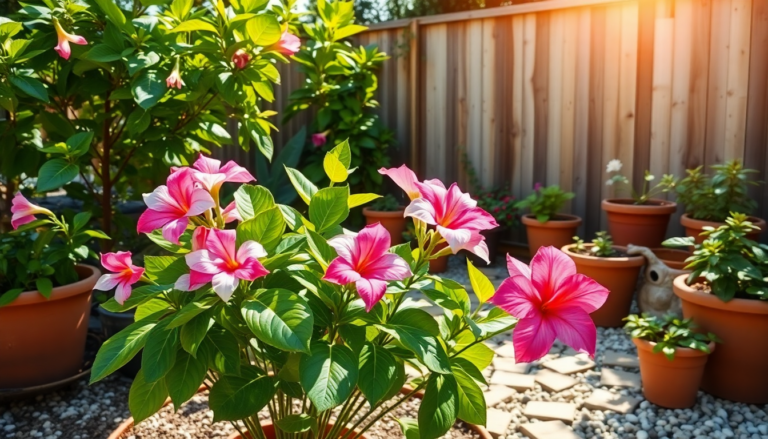Argomenti trattati
As summer rolls in, garden enthusiasts everywhere are eager to spruce up their outdoor spaces with bursts of color. One plant that really steals the show is the mandevilla, known for its lush green leaves and eye-catching trumpet-shaped flowers. This tropical gem isn’t just a visual delight; it’s surprisingly easy to grow, making it a top choice for both beginners and experienced gardeners. Who wouldn’t want a little slice of tropical paradise in their backyard?
Understanding Mandevilla’s Requirements
Originally from the warm, sunny climates of Brazil, mandevilla plants thrive in conditions that mimic their native environment. They love basking in the sun, ideally soaking up six or more hours of direct sunlight each day. Without enough sunlight, you might find these beauties underperforming when it comes to blooming, and nobody wants that! To keep them happy and healthy, it’s crucial to provide well-draining soil—heavy clay just won’t cut it. That’s why many gardeners prefer to pot their mandevillas or hang them in baskets, giving them better control over the soil conditions.
Watering is another key component of mandevilla care. These plants like a moderate amount of water, so let the soil dry out a bit between waterings. This strategy helps prevent root rot while keeping the plant hydrated. When it comes to temperature, mandevillas are happiest in warm weather, ideally between the 60s and mid-90s Fahrenheit. If you live in a colder area outside of USDA Hardiness Zones 9 to 11, you’ll need to bring these beauties indoors during the chilly months to protect them from frost. Who knew gardening could be so strategic?
Fertilizing and Growing Techniques
If you want your mandevillas to flourish and produce a wealth of blooms, regular fertilization is a must. Start with a slow-release granular fertilizer when you plant them, and then switch to a water-soluble fertilizer every two weeks during the growing season. These feeding habits will keep your plants vigorous and encourage continuous flowering. While pruning isn’t strictly necessary, giving a little shape to unruly plants can work wonders. Just remember to wear gloves—nobody wants a sap-induced skin irritation!
For those interested in growing climbing varieties of mandevilla, setting up a trellis or support from the get-go is crucial. These plants love to twine around structures, which not only supports their growth but also boosts their visual appeal. And if you’re in a warm climate, don’t forget about overwintering! A little trim here and there, along with finding a sunny indoor spot (grow lights can be a game-changer if natural light is scarce), will keep your mandevilla thriving through the colder months.
Identifying Pests and Maintaining Health
Like any plant, mandevillas can fall victim to pests, especially when grown indoors. Watch out for common culprits like aphids, spider mites, and mealybugs. A quick inspection of the undersides of leaves while watering can help you catch any infestations early. If you do spot pests, using insecticides according to the label instructions can help tackle the problem. Interestingly, outdoor mandevilla plants often deal with fewer pest issues, which means keeping an eye on your indoor plants is essential, especially as you transition them for winter. It’s all about staying one step ahead!
One exciting aspect of mandevilla care is the opportunity to propagate them through cuttings, assuming the variety isn’t under patent protection. This offers gardeners a fun way to expand their collection, as long as they provide the right light and watering conditions. Watching a mandevilla grow from a cutting to a stunning flowering plant is incredibly rewarding, showcasing the plant’s resilience and beauty. How cool is that?
Conclusion: Embracing the Mandevilla Experience
The mandevilla plant, with its stunning blooms and lush foliage, is a fantastic addition to any garden or patio. With the right care—think adequate sunlight, smart watering practices, and pest management—gardeners can revel in these tropical wonders all summer long. As we delve deeper into the vibrant world of gardening, the mandevilla remains a shining example of the joy that comes from nurturing nature, bringing both beauty and a touch of the tropics to our outdoor spaces. So, are you ready to add this tropical delight to your garden?

